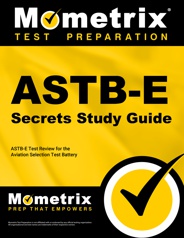The Aviation Standard Test Battery-E (ASTB-E) is utilized by the US Navy and the US Marine Corps to select candidates for the Navy and Marine Corps pilot and flight officer programs, as well as the Navy Officer Candidate School. The US Coast Guard utilizes portions of the ASTB-E to select pilots for training and candidates for its non-aviation officer commissioning program.
ASTB-E Test Format
The ASTB-E is a multiple-choice computer-adaptive test that consists of six subtests. These subtests measure abilities that are essential for success in officer training and aviation-related occupations.
You can opt to take just the Officer Aptitude Rating (OAR) section, consisting of three subtests, or the entire battery consisting of six subtests. If you are not interested in an aviation-related occupation, you only need to complete the OAR section. The OAR portion will take between 1 and 2.5 hours, and the entire battery will take 2 to 3 hours.
- Math Skills Test (MST): This section evaluates your knowledge of college-level math concepts. Topics covered include basic arithmetic operations, solving for variables, fractions, roots, exponents, and the calculation of angles, area, and perimeters of geometric shapes.
- Reading Comprehension Test (RCT): This section tests your ability to read and comprehend passages. You will often be asked to identify the main point of the passage, or whether it supports a particular statement.
- Mechanical Comprehension Test (MCT): This subtest measures your knowledge of basic principles of physics and mechanics. Topics covered included gases and liquids, pressure, volume, velocity, components and performance of engines, principles of electricity, gears, weight distribution, and the operation of simple machines.
The remaining subtests which make up the battery consist of:
- Aviation and Nautical Information (ANIT): Aviation subjects that are tested include aerodynamics, aircraft components, instrumentation, and flight rules and regulations. Nautical information topics include nautical terminology and history, and general carrier terminology.
- Naval Aviation Trait Facet Inventory (NATFI): This is a personality test used in officer selection.
- Performance-Based Measures (PBM): This subtest measures situational awareness, dexterity, spatial orientation aptitude, and ability to multitask. You will have a problem that requires you to identify cardinal directions and then will use a joystick and throttle to track an airplane on a screen. Solving mental rotation problems can help you practice for this section.
Check Out Mometrix's ASTB-E Study Guide
Get practice questions, video tutorials, and detailed study lessons
Get Your Study Guide
Signing Up for the ASTB-E Test
You can register for the exam at any of the following:
- Your nearest Naval Officer Recruiting Station
- The Navy ROTC unit at a major university
- Marine Corps Officer Selection Office
- A military institute
There is no cost for the exam, and the primary test-taking method is by computer.
You also have the option to take the OAR portion as a paper exam. You will need to discuss the method of delivery with the Navy or Marine Corps personnel scheduling the exam. Neither method is more advantageous to the test-taker, as both delivery methods have proven equal results.
Test Day
At your scheduled test appointment, you will need to present some form of state-issued identification and verification of your social security number. You are not allowed to bring anything else into the testing center—everything you need for the exam will be provided to you.
Scoring & Results
Students who complete the full exam will receive four composite scores, and students who complete only the OAR section will receive one score. Score requirements differ by program and service:
| Program/Service | Required Score |
| Officer Candidate School | OAR |
| Student Naval Officer | AQR + PFAR |
| Student Naval Flight Officer | AQR + FOFAR |
- OAR: Officer Aptitude Rating
- AQR: Academic Qualifications Rating
- PFAR: Pilot Flight Aptitude Rating
- FOFAR: Flight Officer Aptitude Rating
The composite scores are based on a stanine scale, meaning the scores range from 1 to 9. Your percentile score is based on how you placed in comparison to other test-takers. So if you receive the average score of 5, it means you performed better than roughly 40-60% of other test-takers.

The OAR is scored from 20 to 80 using one-point increments, with average scores between 40 and 60.
The minimum score requirements for each program are as follows:
| Program | AQR | PFAR | FOFAR |
| Student Naval Aviators | 4 | 5 | |
| Student Naval Flight Officers | 4 | 5 | |
| Marine Pilots & Marine Flight Officers | 4 | 6 | |
| Coast Guard Officer Training School | 4 | 5 |
Should you not pass the exam the first time, you are allowed to take the test up to two more times with at least 31 days between testing dates. This is a lifetime limit, so it’s important to prepare as much as possible before your first attempt. Only your most recent score will be counted, even if it is not your highest score.
You will receive an immediate report of your scores as soon as you complete all six subtests.
Because the exam is computer-adaptive, the number of questions it takes to pass the exam will vary from person to person.
Here’s a look at how the computer-adaptive system works:
The first question is judged to be of medium difficulty, and depending on your performance, the next question may be easier or harder. If you do well on the first question, the second question will be harder; conversely, if you do poorly on the first question, the second question will be easy.
Preparing for the Test
For help in preparing for the exam, check out our ASTB-E Secrets Study Guide. The material is written by exam experts and is designed to give you a complete and easy-to-use study plan for the ASTB-E. The study guide includes practice questions, test-taking strategies, and detailed breakdowns of essential concepts on the exam.
How to Study
Think you aren’t a good test-taker? Maybe on a study-time crunch? Or just don’t know how to begin studying? Mometrix has designed a new Study Secrets course to help every student, no matter what study scenario you are in. Here’s what you’ll find in the Study Secrets Course:
- Techniques to Conquer Procrastination
- Steps to building a Study Plan custom to your learning style
- 7 Effective Note-Taking Methods
- Test-Taking Tips
- Memory Techniques and Mnemonics
- And much more!
Everyone learns differently, so we’ve tailored our Study Secrets Course to ensure every learner has what they need to prepare for their upcoming exam or semester. Click below to check it out!
FAQs
To help you prepare for the exam, you’ll find answers to some of the most common questions about the exam, listed below.
Q
What is the ASTB-E?
A
ASTB-E stands for the Aviation Standard Test Battery-E. The US Navy and US Marine Corps pilot and flight officer programs and Navy Officer Candidate School rely on the ASTB-E as a candidate selection tool, and the US Coast Guard uses ASTB-E subtests to select candidates for pilot training and for its non-aviation officer commissioning program. Those not interested in aviation-related occupations can complete the three Officer Aptitude Rating (OAR) sections only.
Q
How difficult is the ASTB-E?
A
The level of testing can be compared to Graduate Record Examination (GRE) testing. If you complete some ASTB-E practice tests, you will get an idea of how difficult the actual test sections will be. Putting in the hard work studying and preparing will ensure you’re up for any challenge the test might present.
Q
How long is each section of the ASTB-E?
A
With six multiple-choice subtests to complete, the ASTB-E will take candidates 2-3 hours to complete, with the OAR alone taking 1.5-2 hours.
Q
How many times can you take the ASTB-E?
A
A lifetime limit has been set on how many times you can take the ASTB-E. If you aren’t satisfied with your initial score, you can take the exam up to two more times. A 31-day wait is required between each test sitting. If you retake the test, the most recent scores are used regardless of if they are improved or weaker scores, so be cautious in making this decision.
Q
Is the ASTB-E similar to the ASVAB?
A
Candidates for the US Army Officer Candidate School (OCS) take the Armed Services Vocational Aptitude Battery (ASVAB) rather than the ASTB-E for officer applicants that don’t have a Bachelor’s degree. It does not test for aviation-related knowledge. The level of the ASVAB, then, is more similar to that of the SAT and ACT college entrance exams, tests which the US Army sometimes uses in their assessment of candidates. The ASTB-E, in contrast, reflects a level more like the GRE.
Q
What is a good score on the ASTB-E?
A
If a student takes only the OAR subtests, they’ll receive one score. Students taking the entire ASTB-E will receive four composite scores of 1-9 with 9 being the highest score. Each admission program has a minimum composite score of either 4 or 5 as passing and higher scores preferred. Remember that with retakes, the most recent scores will be used regardless of whether they are higher than the test taker’s previous score(s).
Q
How long should you study for the ASTB-E?
A
Candidates taking the ASTB-E shouldn’t make the mistake of assuming they’ll pass the test without studying or by cramming the night before the test. Take a couple of practice tests online to find out how well you score, then determine how much time you need to study based on how many hours per week you have available. To help improve your scores, our ASTB-E Secrets Study Guide includes a step-by-step plan covering exam content, test-taking secrets, and practice tests questions for the ASTB-E.


